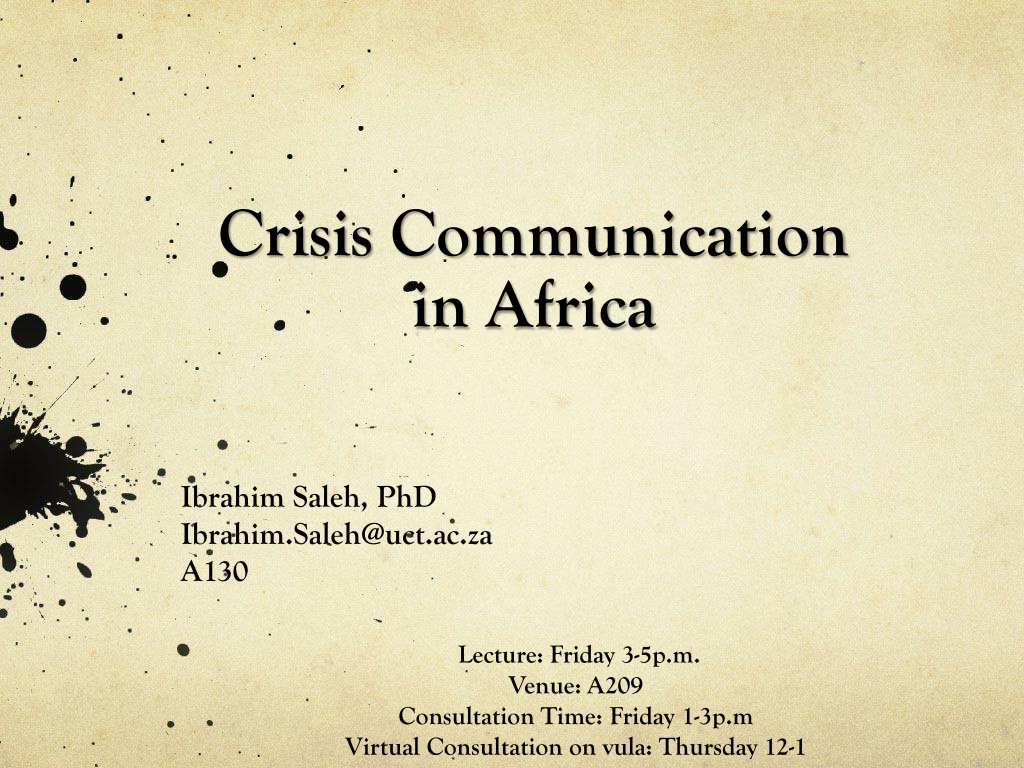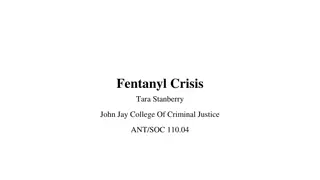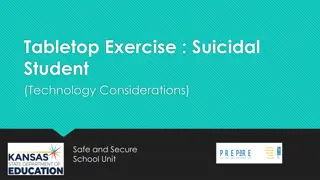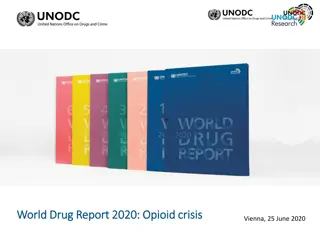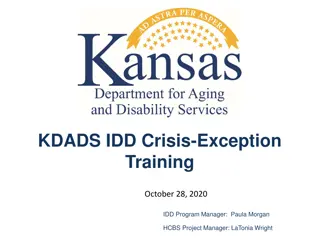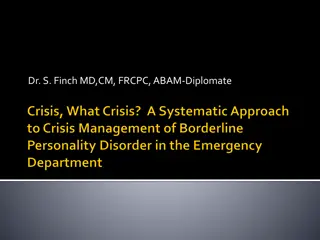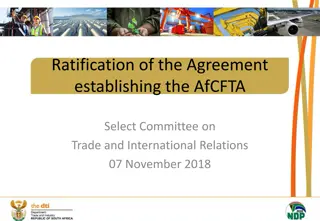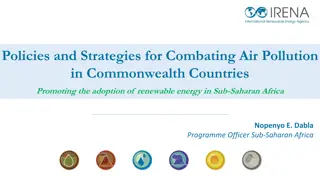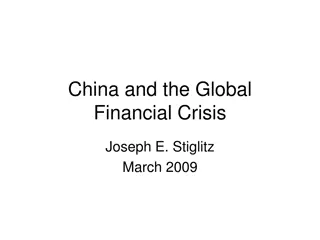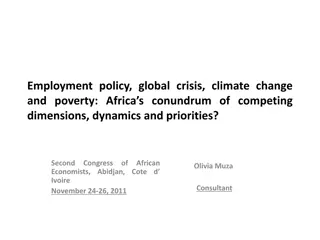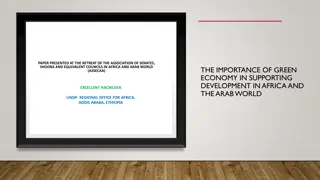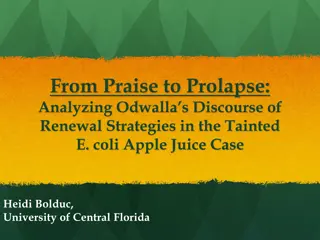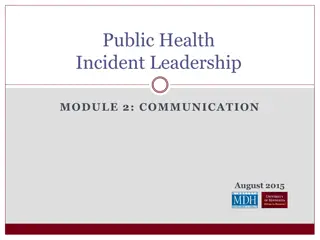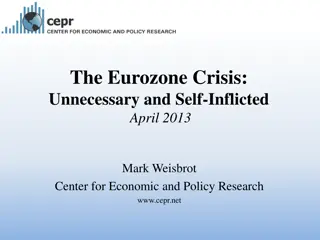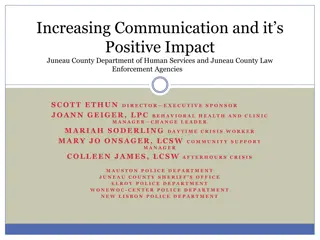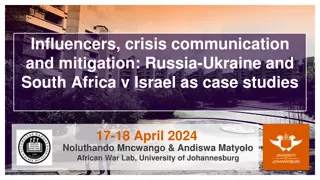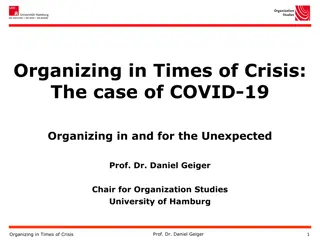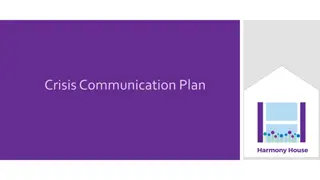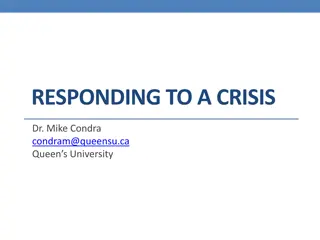Crisis Communication in Africa: Strategies and Challenges
Explore the dynamics of crisis communication in Africa presented by Dr. Ibrahim Saleh. Dive into the theoretical frameworks, media impact, and applications in handling crises. Understand the importance of effective communication during challenging times and how it influences public perception and confidence. Delve into real-world cases like the Marikana massacre to evaluate government communication strategies under pressure. Gain insights into risk communication and its significance in addressing potential hazards and consequences.
Download Presentation

Please find below an Image/Link to download the presentation.
The content on the website is provided AS IS for your information and personal use only. It may not be sold, licensed, or shared on other websites without obtaining consent from the author. Download presentation by click this link. If you encounter any issues during the download, it is possible that the publisher has removed the file from their server.
E N D
Presentation Transcript
Crisis Communication in Africa Ibrahim Saleh, PhD Ibrahim.Saleh@uct.ac.za A130 Lecture: Friday 3-5p.m. Venue: A209 Consultation Time: Friday 1-3p.m Virtual Consultation on vula: Thursday 12-1
The Academic Calendar of the Course: 1: Crisis Communication in Africa: Parameters, Actors and Challenges (Weeks 1 & 2) . 2. Theoretical Framework of Crisis Communication (Weeks 3 & 4) 3. Media, Communication and Crisis Communication (Weeks 5, 6, 7, 8 & 9) 4. Applications, Issues and Crisis Communication (Week 10, 11 & 12)
Position Paper (e.g) From the Marikana massacre to the military disaster in the Central African Republic, the South African government is often criticized for the lack of crisis communication strategies. How do you position yourself with regards to the media performance of the SA government under absolute pressure to break its silence? Select one case and assess the information access and how this availability inspires confidence from the citizenry. The purpose of a position paper is to generate support on an issue, by describing a position on an issue and the rationale for that position. Please remember that your position paper is based on facts that provide a solid foundation for your argument.
Crisis Communication "When written in Chinese the word crisis is composed of two characters. One represents danger and the other represents opportunity. " John F. Kennedy, in an April 1959 Speech
According to Feam-Banks (2007), crisis communication "is concerned with transferring of information to significant persons (publics) to either help avoid or prevent a crisis (or negative occurrence), recover from a crisis, and maintain or enhance reputation" (p. 2).
Risk is defined as the probability of undesired effects (or health outcomes) arising from exposure to a hazard received: Risk = Probability x Consequences. Manuele (2003) defines risk as "the potential for realization of unwanted, negafive consequences of an event" (p. 59).
The U.S. Department of Health and Human Services (2002),Risk communication is an interactive process of exchange of information and opinion among individuals, groups and institutions (p. 4). According to National Research Council (1989), risk communication, "which often involves multiple messages about the nature or risk or expressing concerns, opinions or reactions to risk messages, or to legal and institutional arrangement for risk management "(p. 322)
Crisis Communication: Prepare Vs. React On the fly, is being in a reactive mode and probably not able to gain control of what s going on, which makes you more vulnerable to making mistakes, by saying the wrong thing, and block the way you want to think about. In contrast, the planned approach limits the number of decisions you must make in crisis mode and gives you the tools you need to get right on top of things to maintain control. But the longer it takes to respond to crisis, the greater the likelihood that your organization will suffer some kind of damage to its reputation, credibility, and/or value.
Theoretical Foundations (Covello, et al. , 2001) Trust Determination Model Hazard +Outrage theory Sandman (2003) Negative Dominance Model Mental Noise Model Risk Perception Model
Risk Perception Model: public's perception of risk comes from the strength of 15 different factors, each of which can alter perceptions in varying degrees of magnitude (Covello, et al., 2001, p. 6). These factors determine the public's level of concern and elevate or decrease worries, anger, fear, hostility and outrage; including, Volunteerism, Controllability, Familiarity, Equity, Benefits, Understanding, Certainty, Dread, Trust, Reversibility, Personal, Ethical, Victim, Human and Catastrophic Potential.
Mental Noise Model provides a means for understanding how the public processes information in periods of high stress and anxiety (Covello, et al., 2001, p. 7). As the perceived threat rises, an individual's consequent ability to process information decreases. The creation of mental noise effectively blocks the individual's ability to hear the message and affects his/her willingness and ability to process it. Negative Dominance Model addresses how the public processes negative and positive information in high-concern situations (Covello, et al., 2001, p. 7). The model suggests that the relationship between the two messages is asymmetrical; the negative messages receive substantially more weight than the positive ones. In other words, the public places more value on their losses than on their gains.
Trust Determination Model highlights the importance of establishing trust in all forms of risk and crisis communications (Covello, et al., 2001). Trust comes first in all messages, regardless of purpose or content. Without it, success will be limited. Further, the trust required to fully engage the public in the message is a long-term process. It requires thoughtful processes and methods in addition to sound communication skills.
Hazard +Outrage theory Sandman (2003) The success of risk and crisis communications rests on the communicator's clarity of the theory and how to apply it to the situation at hand. Hazard is the actual event addressed by the communication. It can be a potential future event that the message is attempting to prepare a receiver for, or an actual event that is occurring or is about to occur. Hazards or hazardous events fall anywhere along the continuum from negligible to catastrophic. Getting the message receiver (usually the public or some stakeholder group) to understand the seriousness of the event is a significant determining factor of the success of the message and the action the message receiver takes as a result of hearing it. Outrage refers to the emotions and behaviours of message receivers given their perceptions of the hazard level presented to them. Like hazards, the level of outrage exists on a continuum from high to low
Crisis Communication in Africa Ibrahim Saleh, PhD Ibrahim.Saleh@uct.ac.za A130 Lecture: Friday 3-5p.m. Venue: A209 Consultation Time: Friday 1-3p.m Virtual Consultation on vula: Thursday 12-1
Statement of the Problem The mantra of 'local solutions to local problems' locates the causes of crises firmly within those societies in crisis, which justifies international disengagement, and the denial of international responsibility for the genesis and prolongation of humanitarian crises in Africa. Assigning solutions to the poor, the marginalised and victimised through enhanced 'participation' and local financing of services sustains a myth that development is occurring, when in fact levels of distress are rising (Bradbury, 1998).
Normalizing Crisis When chronic instability and humanitarian crises are redefined as opportunities for development, the central assumption is that these crises are temporary phenomena. Accordingly, a process of 'normalisation' is characterised, by a creeping acceptance of higher levels of vulnerability, malnutrition and morbidity.
Uncertainty Presuming a model that posits an early return to stability either fails to understand or ignores the nature of these emergencies. As David Keen (1994) and others have pointed out that ignoring large-scale population crises will only serve the military, political and economic functions. For many developing societies; including Africa, responses to crises are selective, and sometimes marginalize the core problems through mediatising certain 'acceptable' rates of malnutrition, hardships, which suggests there has been an accommodation with these crises. Explicit criteria or standards for defining when an emergency is an emergency are missing. Mandates are slipping or not being adhered to.
Behind the rhetoric of sustainability lies the problem of sustaining the financing of large-scale humanitarian relief operations. In Rwanda UNICEF s expenditure has declined from US$100 million between 1994 7, to $36 million for the three years 1998 2000 (Macrae and Bradbury, 1998). This internalisation of the costs of war reflects a broader view of contemporary wars in Africa that they are internal wars, and that their causes and solutions lie within.
